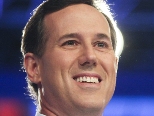 Monday was Alice Stewart’s first day on the job as Rick Santorum’s national press secretary, but she never left her house.
Monday was Alice Stewart’s first day on the job as Rick Santorum’s national press secretary, but she never left her house.
The newly hired spokeswoman did not go into the Santorum campaign’s headquarters, because the campaign didn’t have one.
Instead, Stewart, who was brought aboard thanks to a fresh infusion of cash following the former Pennsylvania senator’s primary and caucus wins last week, spent the day on a series of conference calls that she fielded from her home office in Little Rock, Ark.
She talked strategy with a handful of senior staff and volunteers in states as far-flung as South Carolina, Virginia, Iowa and Tennessee, from 7 a.m. to 6 p.m.
Santorum has rejected many of the trappings of a traditional presidential candidate, particularly one who is now running neck-and-neck with Mitt Romney in national polls. And it’s not just that Santorum doesn’t have an official campaign headquarters.
Santorum travels light. He does not keep a large contingent of advisers in tow as he crisscrosses the country, and he still has no paid advance staff to ensure events run smoothly. There’s no one to scout locations, to test audio equipment or to come up with a Plan B when rain starts falling on the candidate, the audience and the press.
The campaign relies often on volunteers. Monday night in Tacoma, Wash., the GOP State party head said he got a call from campaign representatives mere days before to see if the party could put an event — a rally — together.
The short notice left the candidate addressing a damp crowd (a light rain started about 30 minutes after the rally began) in almost total darkness at the night-time outdoor get-together. The darkness created a glow around the candidate’s face that made him look as if he were about to tell a ghost story.
The rally, held at the Washington Historical Museum, also happened to be adjacent to an Occupy Tacoma encampment. Seizing the opportunity, about a dozen protesters planted themselves in the front row and heckled, shouted and chanted throughout Santorum’s speech. Two of them were dragged off and arrested, and another showered glitter on the candidate — at least the sixth time he’d beem “glitter bombed” on the campaign trail. (She, too, was arrested.)
Despite Monday’s mishaps, Santorum has proved that a candidate on a shoestring budget can still rise in the polls against a better-funded, better-organized opponent. Santorum and his full-time paid staff of more than a dozen aides know the money they are taking in now will need to last for the long haul.
In the days after Santorum’s surprising triple win in Minnesota, Missouri and Colorado last Tuesday, the campaign raised $4 million — an impressive but still modest sum compared with the amounts Romney has been hauling in for months. The Santorum campaign spent only $30,000 on its Iowa win in early January, and all along its approach has been to do more with less.
“We’re not this big bureaucracy, and we’re never going to be,” senior strategist John Brabender said in an interview with ABC News, explaining that the campaign was following a “different model” than traditional presidential efforts.
“But,” he said, “we felt we had to do it differently.”
And the Santorum campaign has become known for cutting costs in ways his opponents never would.
Even an item as basic and relatively inexpensive as a “mult box” — a piece of audio equipment that allows television cameras and radio reporters covering an event to get a clear audio signal — is a rare sight at Santorum’s campaign stops. (The campaign splurged for the boxes during the South Carolina primary and when Santorum stumped in Idaho on Tuesday.)
Months ago, when Santorum was still in the low single digits in national polls, reporters would simply attach a microphone directly to the candidate — often to his signature sweater vest — in order to get higher-quality sound.
The frugality extends to almost every area of Santorum’s presidential bid.
The campaign, for example, does not employ a pollster.
At an event in Idaho on Tuesday night, a campaign aide was spotted filling a manila envelope with cash and checks from enthusiastic donors, a twist on passing the collection plate, and a sight never seen at Romney’s events.
Unlike Romney, Newt Gingrich and even candidates who have bowed out of the race, including Rick Perry, Michele Bachmann and Herman Cain, Santorum has never traveled in a custom-outfitted campaign bus. In Iowa, Santorum’s volunteer adviser, Chuck Laudner, drove the candidate and his small entourage around the state in his pickup truck.
Laudner and his “Chuck Truck,” as it became known, traveled to other early primary states, including South Carolina, to get Santorum to events. At other times, however, Santorum has used a private jet to fly from state to state.
Although more staff members have been added in recent weeks, the campaign still relies on volunteer manpower to fill in the gaps as paid staff members spread themselves across the country. (The campaign maintains a post office box in Verona, Pa., which it lists on official filings with the Federal Election Commission.)
National communications director Hogan Gidley is based in South Carolina, Brabender and spokesman Matt Beynon live in Virginia and deputy campaign manager Jill Latham is in Iowa.
“You can do so much virtually,” Stewart, who was chief spokeswoman for Michele Bachmann’s presidential campaign, said in an interview with ABC News. “And, to be honest, it’s a much more fiscally responsible way to operate.”
{ABC News/Matzav.com Newscenter}











